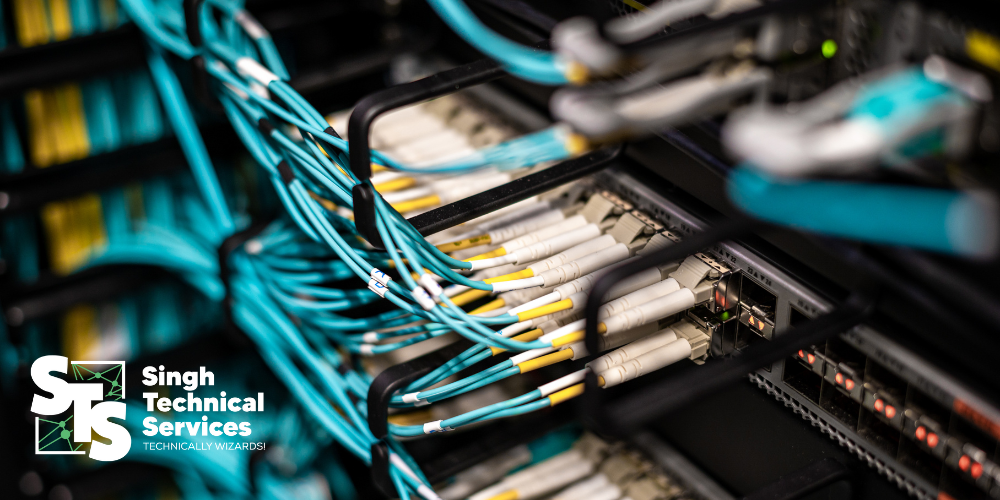What Are the Key Benefits of Installing a Structured Cabling System?

In the modern business environment, a reliable network infrastructure is essential for seamless communication, efficient data management, and overall productivity. A structured cabling system is the backbone of this infrastructure, providing a well-organized and scalable solution for businesses of all sizes. Whether you are setting up a new office or upgrading an existing network, a structured cabling installation can offer numerous benefits that contribute to smoother operations, reduced downtime, and long-term savings.
At Singh Technical Services, we specialize in providing high-quality structured cabling solutions tailored to meet your business’s specific needs
How Does Structured Cabling Enhance Network Efficiency and Performance?
A well-designed structured cabling system improves network efficiency by eliminating the chaos of tangled wires and disorganized connections. By using a centralized cabling infrastructure, businesses can enjoy faster data transmission and more reliable connectivity across their network. With a streamlined system, bandwidth usage is optimized, which ensures that data-heavy applications and communications run smoothly without slowdowns.
The performance of your network will improve significantly, and devices connected to the system will be able to communicate with each other more quickly and efficiently. This leads to better overall productivity, allowing your business to function without the frustration of network lags or connectivity issues.
How Can Structured Cabling Support Business Growth?
One of the primary benefits of structured cabling installation is its scalability. As your business grows, your network infrastructure will need to evolve to accommodate more devices, users, and applications. Structured cabling systems are designed to grow with your business. Whether you’re adding new employees, expanding office space, or incorporating additional technology, the structured setup makes it easy to scale without the need for a complete network overhaul.
By installing a structured system, you ensure that your network can expand seamlessly, avoiding the need for constant upgrades or costly system replacements. This adaptability allows businesses to manage growth effectively without worrying about network performance degradation.
Can Structured Cabling Reduce Downtime and Improve Troubleshooting?
Network downtime can be costly for businesses, leading to lost productivity and revenue. A structured cabling system reduces the chances of downtime by making it easier to identify and fix network issues. With all cables clearly labeled and organized, technicians can quickly locate the source of any problem, which results in faster resolutions.
Furthermore, structured cabling simplifies future troubleshooting and maintenance. The system’s organized nature allows for a more efficient response to problems and fewer disruptions to daily operations. This makes a structured cabling system a smart investment for businesses that rely on continuous connectivity and minimal downtime.
How Does Structured Cabling Make Office Changes Easier?
In today’s dynamic workplace, flexibility is key. A structured cabling installation provides the versatility to adapt to changing office layouts, seating arrangements, or network configurations without major disruptions. As your business needs evolve, the structured system allows you to easily add, remove, or relocate devices, servers, and workstations.
This adaptability ensures that your network remains organized and functional, even as your business space or layout changes. Rather than dealing with the chaos of reconfiguring your network every time you make a change, structured cabling offers a streamlined approach that can grow and shift with your needs.
Is Structured Cabling a Cost-Effective Long-Term Investment?
While the initial cost of structured cabling may seem significant, the long-term savings are undeniable. With a structured system, you eliminate the need for frequent network upgrades or repairs due to disorganization or outdated wiring. The cabling system is built to last, meaning fewer maintenance costs and a longer lifespan for your network infrastructure.
In addition, the reduced downtime and improved network performance mean fewer interruptions to your business activities, saving you both time and money. Structured cabling systems can help you avoid costly outages and maintenance fees, providing a better return on investment over time.
How Does Structured Cabling Improve Office Aesthetics and Safety?
A structured cabling system not only improves network performance but also contributes to a cleaner, more organized office environment. By routing cables through walls, ceilings, or under floors, you eliminate the mess of exposed wires and create a professional, tidy workspace. A cleaner office space also contributes to a more productive environment and a better overall experience for employees and visitors.
Additionally, a well-organized system reduces the risk of tripping hazards caused by loose cables. By minimizing these safety risks, you create a safer working environment for everyone.
FAQs About Structured Cabling Systems
Q1: What is the difference between structured cabling and traditional cabling?
A1: Structured cabling is a standardized and organized network wiring system that connects all devices in an office, supporting data, voice, and video communication. Unlike traditional cabling, which can be disorganized and difficult to maintain, structured cabling offers better scalability, performance, and ease of management.
Q2: How can I tell if my business needs a structured cabling system?
A2: If your business is experiencing slow network speeds, frequent downtime, or if you’re adding more devices to your network, it might be time for a structured cabling installation. The system will help improve performance, scalability, and efficiency as your business grows.
Q3: Can I install a structured cabling system myself?
A3: While it’s possible to install a structured cabling system on your own, it’s recommended to hire professionals to ensure proper installation and configuration. Singh Technical Services has the expertise to design and implement a structured cabling solution that meets your business’s specific needs.
Q4: How long does it take to install a structured cabling system?
A4: The installation timeline depends on the size of your office and the complexity of your network setup. On average, structured cabling installation can be completed in a few days, minimizing disruption to your daily operations.
Q5: How often does structured cabling need to be maintained?
A5: Structured cabling systems require minimal maintenance. However, it’s important to perform occasional checks to ensure cables remain in good condition and that connections are functioning properly. Regular maintenance ensures the longevity of your system and prevents network performance issues.
Conclusion: Ready to Upgrade Your Network Infrastructure?
A structured cabling system offers numerous benefits that can enhance the performance, scalability, and reliability of your network. Whether you’re looking to improve efficiency, reduce downtime, or make office changes easier, structured cabling is a smart investment. At Singh Technical Services, we specialize in providing high-quality structured cabling installation solutions that are tailored to your business’s needs.
Contact us today to learn more about how we can help improve your network infrastructure and ensure your business remains connected and efficient.
